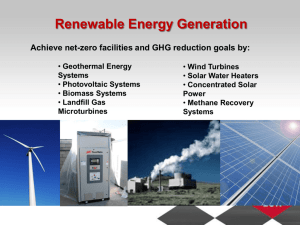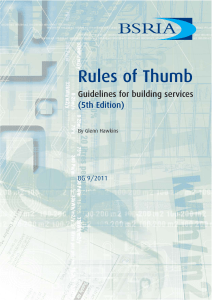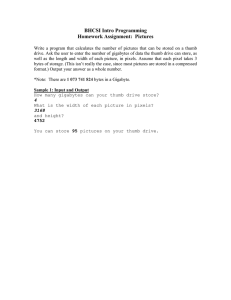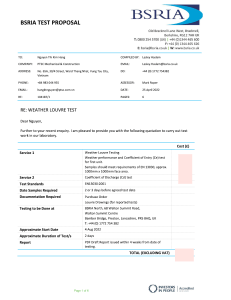Rules of Thumb Guidelines for building services (5th Edition)
advertisement
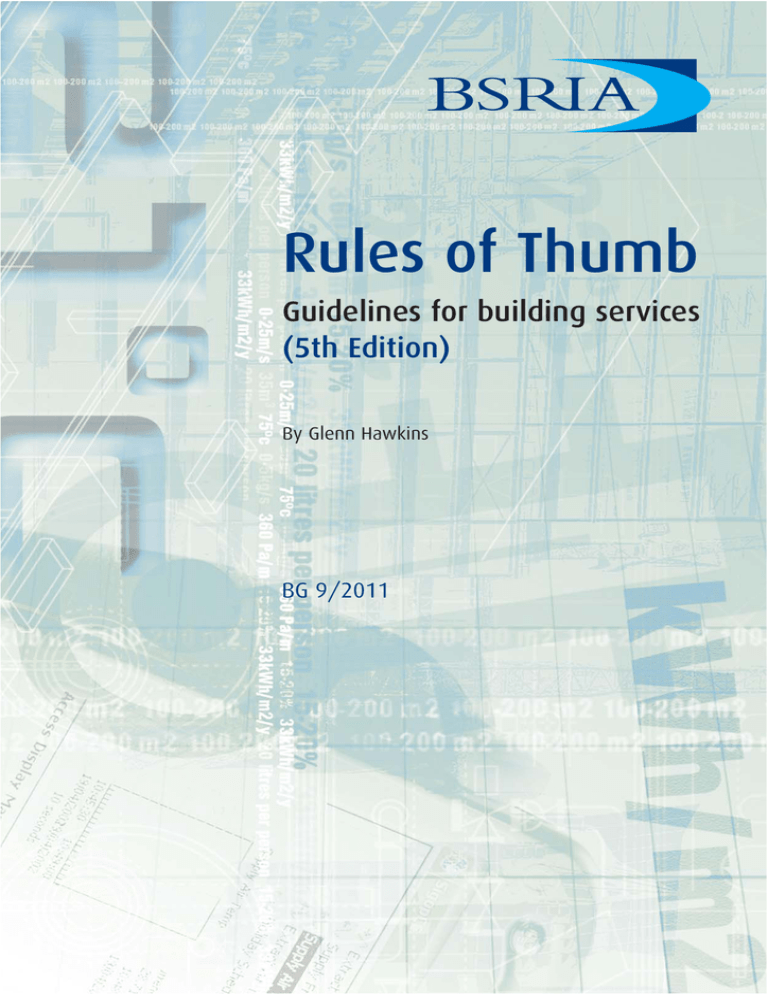
Rules of Thumb Guidelines for building services (5th Edition) By Glenn Hawkins BG 9/2011 Acknowledgements BG 9/2011 Rules of Thumb provides a valuable source of approximate engineering design, environmental performance and project cost data for building services projects. It is therefore an indispensable reference document for construction professionals. The BG 9/2011 Rules of Thumb has been written by BSRIA’s Glenn Hawkins and has been designed and produced by Ruth Radburn. BSRIA would like to thank the following companies and people for providing information and guidance during the production of this publication: Companies AECOM Bovis Lend Lease Buccleuch Energy Buderus Chloride Power Cundall Johnson Hoare Lea Mace Piller Prupim Sense Cost Consultancy Skanska Rashleigh Weatherfoil Spirax Sarco WSP People Ian Blakeman Philip Clarke Nick Cullen Keith Horsley Mitchell Layng Jim Mellish Chris Parsloe Walter Poetsch Les Smith Richard Tudor Duncan Yarroll This publication has been printed on Nine Lives Silk recycled paper. All rights reserved. No part of this publication may be reproduced, stored in a retrieval system, or transmitted in any form or by any means electronic or mechanical including photocopying, recording or otherwise without prior written permission of the publisher. ©BSRIA 53247 March 2011 ISBN 978 0 86022 692 5 Printed by ImageData Ltd RULES OF THUMB 5TH EDITION © BSRIA BG 9/2011 1 Preface The origin of the term “Rule of Thumb” is unclear. It is an expression that has been attributed to a diverse range of sources dating back hundreds of years. These include woodworkers using their thumbs as measurement devices, millers assessing the coarseness of ground flour by rubbing it between a thumb and forefinger, brewers testing the temperature of fermenting beers and farmers sowing seeds or setting plants at an approximate soil depth. Whatever the application, a Rule of Thumb can be considered as a general principle or means of estimation derived from practice and experience, rather than precise theory. It represents a method for broad application that is not intended to be accurate for every situation. However, a Rule of Thumb can be easily learned and applied, which means that it can be extremely useful for approximately calculating a value, setting outline targets or rapidly comparing different options. As a construction project progresses from a client’s statement of need, through design and construction, and into operation and use, project teams seek increased certainty of criteria such as layout, fit, cost and performance. Rules of Thumb, such as those contained in this publication, can provide extremely useful guidance to inform the early stages of this process, such as briefing, feasibility studies and concept design. This may be in the assessment of space and weight requirements, the preparation of outline cost models, the configuration of environmental performance targets or the evaluation of heating, cooling and electrical loads, for example. Furthermore, Rules of Thumb can be employed throughout the project delivery process to sense-check precise calculations, quickly verify the work of junior construction professionals and rapidly perform what-if scenarios for different design options. While every effort has been made to reflect current practice and contemporary building services plant, it is important to acknowledge that the Rules of Thumb are merely aids to the project delivery process. They must not be used in place of detailed design, cost or performance-in-use data. The responsibility for the safe and appropriate use of this data therefore rests with each construction professional. This publication has been designed to be your own personal reference document. Use it, transfer your own data to it, and share what you know with others. And please let us know how it works and where it can be improved. Glenn Hawkins BSRIA, March 2011 RULES OF THUMB 5TH EDITION © BSRIA BG 9/2011 3 Contents About this book 7 Space and weight allowances 8 Figure 1: Figure 2: Figure 3: Figure 4: Figure 5: Figure 6: Figure 7: Figure 8: Figure 9: Figure 10: Figure 11: Figure 12: Figure 13: Figure 14: Figure 15: Figure 16: Figure 17: Figure 18: Figure 19: Figure 20: Figure 21: Figure 22: Figure 23: Figure 24: Figure 25: Figure 26: Figure 27: Figure 28: Figure 29: Figure 30: Figure 31: Figure 32: Figure 33: Figure 34: Figure 35: Figure 36: Figure 37: Figure 38: Figure 39: Table 1: Table 2: Air cooled condenser – area and height requirements Air cooled condenser – operating weight Air handling units – area and height requirements Air handling units – operating weight Biomass boiler plantroom – area and height requirements Biomass boiler – operating weight Gas fired boiler plantroom – area and height requirements Gas fired boiler – empty and operating weight Horizontal calorifiers – area and height requirements Horizontal calorifiers – operating weight Vertical calorifiers – area and height requirements Vertical calorifiers – operating weight Air cooled chillers – area and height requirements Air cooled chillers – operating weight Water cooled chillers – area and height requirements Water cooled chillers – operating weight Forced draught cooling towers– area and height requirements Forced draught cooling towers – operating weight Induced draught cooling towers – area and height requirements Induced draught cooling towers – operating weight Cold water storage – area and height requirements Cold water storage – operating weight Diesel generators – area and height requirements Diesel generators – operating weight Diesel rotary UPS – area and height requirements Diesel rotary UPS – operating weight Hybrid rotary UPS – area and height requirements Hybrid rotary UPS – operating weight Static UPS – area and height requirements Static UPS – operating weight Packaged substations – area and height requirements Packaged substations – operating weight UPS battery rooms – area and height requirements UPS battery systems – operating weight Switchrooms – area and height requirements Switchroom panels – operating weight Transformers – area and height requirements Transformers – operating weight Biomass fuel storage – area requirements Space requirements for lift installations Floor space allowances for building services in different types of building – as a percentage of gross internal area (GIA) Figure 40: Ceiling and floor voids in a generic office building Figure 41: Space requirements and reach distances for installation and maintenance tasks Table 3: Building occupancy densities Table 4: Minimum structural loadings 9 9 10 10 11 11 12 12 13 13 14 14 15 15 16 16 17 17 18 18 19 19 20 20 21 21 22 22 23 23 24 24 25 25 26 26 27 27 28 29 System features – Mechanical building services 36 Table 5: Table 6: Table 7: Table 8: 36 38 39 Table 9: Sizing and operating characteristics of hydronic heating and cooling systems Sizing and operating characteristics of steam systems Commissioning of hydronic heating and cooling systems Minimum provision of sanitary appliances for staff in offices, shops and factories (for male and female staff where urinals are not installed) Minimum provision of sanitary appliances for staff in offices, shops and factories (for male staff only where urinals are installed) 30 31 32 34 35 40 40 RULES OF THUMB 5TH EDITION © BSRIA BG 9/2011 5 System features – Mechanical building services (continued) 36 Table 10: Sizing and operating characteristics of public health systems Table 11: Sizing and operating characteristics of ventilation systems Table 12: Sizing and operating characteristics of fire engineering systems 41 43 46 System features – Electrical building services 47 Table 13: Sizing and operating characteristics of electrical building services systems and components Table 14: Classification of fire detection systems 47 50 System features – Natural ventilation 51 Table 15: Design of natural ventilation systems 51 Cooling and heating loads 52 Table 16: Cooling loads for different types of building (W/m gross internal area, unless otherwise stated) Table 17: Internal heat gains in offices (W/m2 net internal area, unless otherwise stated) 2 Table 18: Heating loads for different types of building (W/m gross internal area, unless otherwise stated) 52 53 53 Electrical loads 54 2 Table 19: Electrical loads for different types of building (W/m gross internal area, unless otherwise stated) 2 Table 20: Electrical loads for different types of building – continued (W/m gross internal area, unless otherwise stated) 2 Table 21: Small power and electrical loads in offices (W/m net internal area, unless otherwise stated) 55 55 Water consumption 60 Table 22: Maximum daily hot water demand and total water demand for different types of building Table 23: Minimum storage of cold water for domestic purposes (hot and cold water outlets) in different types of building Table 24: Minimum storage of hot water for domestic purposes in different types of building 60 Internal and external design criteria 66 Table 25: Internal environmental design criteria for different types of building Table 26: External environmental design criteria for the UK 66 68 Energy and carbon 69 Table 27: Table 28: Table 29: Table 30: 69 70 72 74 2 6 CO2 emissions factors for different fuel types Annual energy consumption and CO2 emissions benchmarks for different building types Compliance with Part L of the Building Regulations 2010 Air permeability for different building types 54 63 64 Costs 75 Table 31: Building services installation costs for different building types Table 32: Building services installation costs expressed as a percentage of total construction costs for different building types Table 33: Supply and installation cost of primary building services plant and equipment Table 34: Supply and installation cost of renewable energy plant and equipment Table 35: Annual building services maintenance costs and annual utility costs for different building types Table 36: Life cycle costs of building services over a 30 year period for different building types 2 Table 37: Annual energy cost benchmarks for different building types (£/m GIA unless otherwise stated) 75 80 81 82 83 85 88 Glossary of terms 90 International system of units (SI units) 92 Table 38: SI base units Table 39: Examples of SI derived units 92 92 Conversion factors 94 Table 40: Conversion factors from imperial to SI units Table 41 Conversion factors for energy units 94 95 Index 96 References 97 RULES OF THUMB 5TH EDITION © BSRIA BG 9/2011 About this book This publication is the fifth edition of the Rules of Thumb first issued in 1995. The Rules of Thumb have been created by referencing various contemporary sources in the building services industry and can reasonably be held to reflect current design practices. The sources include major building services design consultancies, concept and scheme design reports produced by construction project teams, leading plant and equipment manufacturers, the Building Regulations and information published by BSRIA, CIBSE and others. This fifth edition contains greatly increased guidance about space and weight allowances that is presented in a new graphical format. CO2 emissions benchmarks are included for the first time and are presented alongside energy consumption benchmarks. Guidance about costs has been made clearer and expanded to include energy consumption, maintenance, operation and life cycle cost information. The section about system features has been clarified and sub-divided into mechanical building services, electrical building services and natural ventilation. In order to reflect the increasing importance of low carbon design, guidance about compliance with Part L of the Building Regulations, renewable technologies and air permeability of buildings has also been included in this update. Each section is colour-coded as follows: Space and weight System features – Mechanical building services, electrical building services and natural ventilation Cooling, heating and electrical loads Water consumption Internal and external design criteria Energy and carbon Costs Readers are advised to use this new edition in place of the previous one, and to transfer over any personal Rules of Thumb they have compiled in the light of experience. RULES OF THUMB 5TH EDITION © BSRIA BG 9/2011 7 SPACE Space and weight allowances How to use the charts of space and weight allowances: Step 1 Read the explanatory notes that accompany each chart Step 2 Project a vertical line from the bottom axis at a point representing the appropriate plant performance requirements of your project Step 3 At the point where the vertical line intersects the red line representing area requirements, project a horizontal towards the red vertical axis. Read off the area required for plant installation. Step 4 At the point where the vertical line intersects the blue line representing height requirements, project a horizontal towards the blue vertical axis. Read off the height required area for plant installation. Please note that although the two vertical axes have different units, they have the same number of tick marks. This means that a ruler can be used to project horizontal lines that are parallel to the bottom axis. 1 4 3 2 The example shown above applies to the dual-axis charts of area and height requirements. For the charts of operating weight, the following approach should be adopted: 8 Step 1 Read the explanatory notes that accompany each chart Step 2 Project a vertical line from the bottom axis at a point representing the appropriate plant performance requirements of your project Step 3 At the point where the vertical line intersects the green line representing operating weight, project a horizontal towards the green vertical axis. Read off the operating weight. RULES OF THUMB 5TH EDITION © BSRIA BG 9/2011 SPACE Figure 1: Air cooled condenser – area and height requirements Figure 2: Air cooled condenser – operating weight Your notes: RULES OF THUMB 5TH EDITION © BSRIA BG 9/2011 9 System features – Mechanical building services Table 5: Sizing and operating characteristics of hydronic heating and cooling systems SYSTEM Description Rule of thumb Classification of water heating systems System design water temperature o ( C) Low pressure hot water (LPHW) 40 – 85 1–3 100 – 120 3–5 > 120 5 – 10 Medium pressure hot water (MPHW) High pressure hot water (HPHW) Maximum water velocities in pipework Comments 1.5 Over 50 mm nominal diameter 1.5 3.0 Nominal diameter is the approximate internal diameter of a pipe 17 Pressure drop per metre run (Pa) Pipe sizing for optimum life cycle energy consumption 200 Pipe sizing for optimum installation costs 300 Copper pipework (l/m) Nominal outside diameter Steel pipework (l/m) Nominal internal diameter 15 mm 0.14 15 mm 0.21 22 mm 0.32 25 mm 0.59 28 mm 0.54 40 mm 1.38 42 mm 1.23 50 mm 2.21 54 mm 2.10 65 mm 3.70 76 mm 4.20 80 mm 5.12 108 mm 8.66 100 mm 8.68 159 mm 18.87 150 mm 18.95 Your notes: 36 16 Steel pipework 1.0 Water capacity per unit length of pipe Account must be taken of varying static pressure in a tall building Maximum water velocity (m/s) 15 – 50 mm nominal diameter Pressure drop for water distribution in pipework 15 Operating static pressure (bar absolute) Copper pipework RULES OF THUMB 5TH EDITION © BSRIA BG 9/2011 Ref 18, 19 Cooling and heating loads 2 Table 16: Cooling loads for different types of building (W/m gross internal area, unless otherwise stated) Description Banks Rule of thumb Comments Cooling load 2 (W/m ) Please refer to the glossary for a definition of gross internal area 160 Data centres 1500 Hotels 150 Offices 87 LOADS Restaurants 200 Retail establishments 140 Residential buildings 70 This figure is based on the net area of the data hall Depending on occupancy, a peak guest room cooling load between 1.5 kW and 2 kW will normally be adequate for the UK The project design reports analysed during the production of this document had an average total 2 cooling load of 87 W/m GIA* Comments: 2 *Solar gains vary with façade orientation and should fall in the range of 50 – 65 W/m of the 4.5 m deep perimeter zone. Please refer to Table 17 for guidance about internal heat gains in offices. Your notes: 52 RULES OF THUMB 5TH EDITION © BSRIA BG 9/2011 Ref 61, 12 Water consumption Table 22: Maximum daily hot water demand and total water demand for different types of building Description Rule of thumb Maximum daily hot water consumption (l/person) Comments Maximum daily total water consumption (l/person) Houses Economic, local authority 115 120 Medium, privately owned 115 120 Luxury, privately owned 120 120 Flats WATER Economic, local authority 68 120 Medium, privately owned 115 120 Luxury, privately owned 120 120 60 Nursing staff accommodation 120 120 Hostels 115 120 RULES OF THUMB 5TH EDITION © BSRIA BG 9/2011 The Code for Sustainable Homes (2010) sets a maximum daily water consumption of 120 litres per person per day. 80 litres per person per day is proposed for the best performing homes 37, 65, 66 The Code for Sustainable Homes (2010) sets a maximum daily water consumption of 120 litres per person per day. 80 litres per person per day is proposed for the best performing homes 37, 65, 66 65, 66, 67 Other types of dwelling Your notes: Ref Table 26: External environmental design criteria for the UK Description Rule of thumb Comments Ref External design o temperature ( C) Winter design temperature for heating Design of heating systems -4 saturated The rate of lowering external design temperature for any increase in altitude above sea level should be – O 0.6 C per 100 m 75, 12 76, 12 Summer design temperatures Calculation of cooling loads for air conditioning systems 29 dry bulb/ 20 wet bulb Selection of heat rejection equipment 35 Comments: The above information is for general application to UK cities. Detailed guidance for specific UK and international locations can be found in CIBSE Guide A: Environmental Design. Your notes: DESIGN 68 RULES OF THUMB 5TH EDITION © BSRIA BG 9/2011 Energy and carbon Table 27: CO2 emissions factors for different fuel types Fuel type Carbon emissions factor (kgCO2/kWh) Mains gas 0.198 LPG 0.245 Heating oil 0.274 Wood pellets 0.028 Wood chips 0.009 Grid supplied electricity 0.517 Grid displaced electricity 0.529 Waste heat 0.058 Dual fuel (mineral + wood) 0.206 Comments Ref 77 ENERGY Your notes: RULES OF THUMB 5TH EDITION © BSRIA BG 9/2011 69 Table 28: Annual energy consumption and CO2 emissions benchmarks for different building types Building type Annual energy consumption benchmarks Annual CO2 emissions benchmarks Electricity Electricity 2 (kWh/m ) Bars, pubs or licensed clubs Fossil thermal (kWh/m2) 2 (kg CO2/m ) Fossil thermal (kg CO2/m2) Comments Total (kg CO2/m2) These type of facilities serve drinks and snacks and have standing and seating areas for customers 130 350 67.2 69.3 136.5 70 200 36.2 39.6 75.8 Doctors’ surgeries, health clinics, veterinary surgeries and dentists Cold storage 145 80 75.0 15.8 90.8 Refrigerated warehouses without public areas Covered car parks 20 0 10.3 0.0 10.3 This type of building is a car park with roof and side walls Cultural venue 70 200 36.2 39.6 75.8 Museums, art galleries and libraries Dry sports and leisure facility 95 330 49.1 65.3 114.5 Dry sports halls, sports grounds with changing rooms, tennis courts with office and stadiums Emergency services 70 390 36.2 77.2 113.4 Police, fire and ambulance stations Entertainment hall venues 150 420 77.6 83.2 160.7 Cinemas, theatres, concert halls and bingo halls Fitness and health centre 160 440 82.7 87.1 169.8 Fitness, aerobics and dance facilities 60 300 31.0 59.4 90.4 Boarding houses, university and school hostels and nursing homes General retail 165 0 85.3 0.0 85.3 High street stores or local stores, corner shops, takeaways, hairdressers, laundrettes and dry cleaners High street agency 140 0 72.4 0.0 72.4 Bank branches, estate agents, travel agents, Post Offices and betting shops 90 420 46.5 83.2 129.7 Acute hospitals, specialist hospitals, teaching hospitals and maternity hospitals 105 330 54.3 65.3 119.6 This building category includes all types of hotels Clinics General accommodation Hospitals (clinical or research) Hotels Comments: 2 Values for energy consumption are for delivered energy used per unit of floor area. Areas in m are gross floor areas, measured as RICS gross internal area (GIA). ENERGY Figures for energy consumption are derived from CIBSE TM 46: 2008, Energy benchmarks. CO2 emission factors used to calculate CO2 emissions benchmarks: Electricity: 0.517 kgCO2/kWh, Fossil thermal: 0.198 kgCO2/kWh (fuel assumed to be natural gas). (These figures are taken from The Government’s Standard Assessment Procedure for Energy Rating of 77 Dwellings, October 2010 .) Your notes: 70 RULES OF THUMB 5TH EDITION © BSRIA BG 9/2011 Costs Table 31: Building services installation costs for different building types Airport terminal Element of the mechanical and electrical services Sanitaryware £/m 2 % of total M&E cost Shopping mall £/m 2 Office – city centre Office – city centre (Shell and core) (Cat A fit-out) % of total M&E cost £/m 2 % of total M&E cost £/m 2 % of total M&E cost 2.7 0.3 0.7 0.2 6.48 1.8 0.0 0.0 Disposal installations 14.0 1.5 10.7 3.5 18.91 5.2 7.4 2.7 Water installations 16.3 1.7 10.7 3.5 12.74 3.5 0.0 0.0 347.3 37.0 62.4 20.5 106.46 29.5 140.6 50.5 Ventilating services 42.4 4.5 46.3 15.2 41.8 11.6 0.0 0.0 Electrical installation 259.9 27.7 110.7 36.3 97.99 27.2 77.8 27.9 1.8 0.2 0.8 0.3 1.24 0.3 0.0 0.0 46.9 5.0 13.5 4.4 30.59 8.5 21.3 7.6 156.7 16.7 33.3 10.9 23.11 6.4 12.6 4.5 49.6 5.3 15.8 5.2 20.98 5.8 19.0 6.8 937.6 100.0 304.7 100.0 360.3 100.0 278.6 100.0 Space heating and air treatment Gas installation Protection systems Communication Special installations* Total cost Comments: Costs derive from the SPON'S 2011 M&E price book and have been cross-referenced with information provided by Sense Cost Consultancy. The costs do not include VAT. They do include preliminaries, profit and overheads for the building services contractor. All areas are gross internal area (GIA) unless otherwise stated. All prices apply to the London area. Apply the following factors to obtain regional prices: South East: 0.94, South West: 0.9, East and West Midlands: 0.85, East Anglia: 0.84, North East: 0.86, North West: 0.84, Scotland: 0.92, Wales: 0.88, Northern Ireland: 0.68. Airport terminal: New build terminal building. 25,000 m2 GIA. Costs exclude baggage handling, check-in systems, pre-check-in and boarding security systems, vertical transportation and services to aircraft stands. Heat source via district mains. Space heating and air treatment includes LTHW heating system, chilled water system, supply and extract air conditioning system and an allowance for services to communications rooms. Electrical installation includes HV/LV switchgear, standby generator, mains and sub mains installation, small power installation, lighting and luminaires, emergency lighting, and power to mechanical services. Communications installations include fire and smoke detection and alarms, voice/public address systems, intruder detection, security, CCTV and access control, wireways for telephones data and structured cable, structured cable installation, flight information display system. Shopping mall: Two storey, naturally ventilated shopping mall of 33,000 m2. Space heating and air treatment includes condenser water system, LTHW installation, air conditioning system and over-door heaters at entrances. Electrical installation includes LV distribution, standby power, general, external and emergency lighting, small power, mechanical services supplies and UPS for security and CCTV. Cost associated with tenants' fit-out and car parking are not included in this cost model. Office – city-centre: Speculative 15 storey office in Central London of 19,300 m2 GIA for multiple tenant occupancy. Four pipe fan coil unit system with roof mounted cooling towers, gas fired boilers and water cooled chillers in the basement. Ventilating services include toilet and basement extract and miscellaneous ventilation systems. Electrical installation includes generator, HV/LV supply and distribution, general lighting and power systems and electrical services to mechanical equipment. Fit-out costs are £/m2 NIA, based on a NIA of 12,500 m2. * Building management system [BMS], unless otherwise stated. COSTS Your notes: RULES OF THUMB 5TH EDITION © BSRIA BG 9/2011 75 Glossary of terms Term Description Boiler efficiency (%) The energy delivered by the water as it leaves the boiler to supply the heat emitters Ref 78 The energy (based on gross calorific value) in the fuel delivered to the boiler Seasonal boiler efficiency (%) is a weighted average of the efficiencies of a boiler at 15%, 30% and 100% of the boiler output Building services A collective term for the systems required for the safe, comfortable and efficient operation of the built environment. This includes energy supply and distribution, heating, air-conditioning, ventilation, refrigeration, lighting, lifts, escalators, ICT networks, security, alarms, fire detection and fire protection 82 Category A fit-out Category A fit-out works extend central services out on to floor plates and provide a background for Category B works. Category A works comprise services, life safety elements and basic fittings and finishes for the operation of lettable work space, including: 6 Category B fit-out 90 x Suspended ceilings x Raised floors and skirtings x Cooling and heating systems x Office ventilation systems x Open plan base lighting solution x Life safety systems, such as fire alarms, sprinklers and emergency lighting x Distribution boards x Office carpet and floor boxes x Blinds x Basic statutory signage x Basic security systems and wireways Category B works, or bespoke fit-out, may include: x Suspended ceiling upgrades x Special area fitting out, such as auditoria, kitchens, restaurants and meeting rooms x Upgrade to core finishes x Internal partitioning x Additional floor finishes x Mechanical, electrical and lighting upgrades x Installation of below-floor and overhead/drop-down power distribution x IT and telecommunications installations and distribution (data cabling) x Enhanced WC provision, if required x Occupier standby generation and uninterruptible power supplies (UPS) x Adaptation of life safety systems x Decoration and branding x Fixtures and fittings x Furniture x Security installation enhancements x Audio-visual installations x Corporate and way-finding signage x Vertical transportation enhancements x Feature staircase links between floors RULES OF THUMB 5TH EDITION © BSRIA BG 9/2011 6 Conversion factors Table 40: Conversion factors from imperial to SI units Unit Imperial Length Area Volume Mass SI (Approximate) 1 inch 25.4 mm 25 mm 1 foot 0.3048 m 0.3 m 3.28 feet 1m 1 yard 0.9144 m 1 mile 1.609 km 0.9 m 1.6 km 2 1 sq. in 645.2 mm 1 sq. ft 0.093 m 10.77 sq. ft. 1m 1 sq. yd 0.836 m 1 cu. in 16.39 cm 1 cu ft 28.32 litre 650 mm 2 0.1 m 2 0.84 m 2 2 2 3 16 cm 2 3 28 litre 3 35.32 cu ft 1m 1 pint 0.568 litre 0.6 litre 1 gallon 4.546 litre 4.5 litre 1 pound 0.4536 kg 0.45 kg 2.205 pounds 1 kg 1 ton 1.016 tonne 3 1 tonne 1 lb/cu.ft 16.02 kg/m Volume flow rate 1 gall/minute (g.p.m) 0.076 litre/s 0.08 litre/s 1 cu.ft/minute (c.f.m) 0.472 litre/s 0.5 litre/s 1 foot/minute 0.0051 m/s 0.005 m/s 197 feet/minute 1.0 m/s 1 mile/hour 0.447 m/s 0.5 m/s 1 British thermal unit (Btu) 1.055 kJ 1 kJ 1 ‘Old’ therm (100 000 Btu) 105.5 MJ 100 MJ 1 Btu/hour 0.2931 W 0.3 W 1 horsepower 745.7 W 750 W 1 tonne refrigeration (12 000 Btu/hour) 3.517 kW 3.5 kW Intensity of heat flow rate 1 Btu/hour sq. ft 3.155 W/m2 Transmittance (U value) 1 Btu/hour sq. ft oF 5.67 W/m2K 6 W/m2K Conductivity (k value) 1 Btu inch/hour sq. ft oF 0.1442 W/mK 0.15 W/mK Heat Heat flow rate RULES OF THUMB 5TH EDITION © BSRIA BG 9/2011 16 kg/m 3 Density Velocity 94 SI (Exact) 3 W/m2 Index Air cooled chillers 15, 81 Air cooled condenser 9 Air handling units 10, 81 17, 81 Gas fired boilers 81 Heating loads 12, 53 Air permeability 74 Horizontal calorifiers Biomass boiler plantroom 11 Hot water demand 60, 61, 62 Biomass fuel storage 28 Hybrid rotary UPS 22 Boiler plantroom 12 Hydronic heating and cooling systems Building occupancy densities 34 Induced draught cooling towers 18 Internal heat gains 53 Lift installations 29 Packaged substations 24 Building Regulations 7, 72, 73 Ceiling and floor voids 31 CO2 emissions 7, 70, 71 Cold water 63 Part L Cold water outlets 63 Public health systems Cold water storage 19, 63 Renewable energy plant 13 36, 37, 39 7, 72, 73 41, 42 82 Cooling loads 52 Rotary UPS Cooling towers 81 Sanitary appliances 40, 42 21, 22, 81 Design criteria 66, 68 Small power 53, 55 Diesel generators 20, 81 Space requirements 32, 33 Diesel rotary UPS 21, 81 Static UPS 23, 81 Domestic 42, 63, 64, 65, 72, 88, 89 Dry air coolers 81 Electrical building services Electrical loads Energy consumption Steam systems 38 Structural loadings 35 47, 48, 49 Switchrooms 26, 81 54, 55 Transformers 27, 81 7, 36, 70, 71, 73, 88, 89 UPS battery rooms 25 50, 51 Ventilation systems 43, 44, 45, 73, 90 Fire detection systems 96 Forced draught cooling towers Fire engineering systems 46 Vertical calorifiers Floor space 30 Water cooled chillers RULES OF THUMB 5TH EDITION © BSRIA BG 9/2011 14 16, 81
